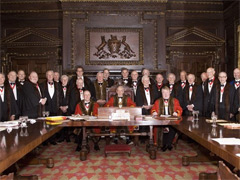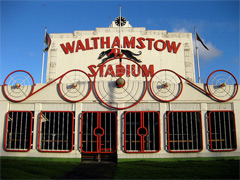


What are they?
Back when the City of London was a self-governing quasi-state, workers in trades like silversmithing and goldsmiths formed unions to protect and control the manufacture of goods, as well as ensuring working conditions and wages were fair. They were a little like trade unions if you can imagine them being a bit more Freemason-esque; guilds’ names all start with “Worshipful Company of”, are headed by a “master” and each have their own badge with a coat of arms. They were also incredibly powerful – by the 16th century London was the world’s capital of commerce with the busiest port, which made the guilds among the most important organisations in Britain.
The word “guild” dates back to medieval times and comes from the Saxon “gildan” which means “to pay”; members of the organisation paid to join. The word “livery” means the distinctive clothing worn by those who were part of the City companies, although the word now seems to have become interchangeable with guilds.
\n\nA Master? Sounds appalling.
Worry not, they’re not slave drivers. The Master is simply the name given to the elected director of the livery, who can also go by a different name depending on the guild (the Fishmongers guild, clearly not comfortable with the worrying connotation of the term, call theirs the Prime Warden).
There are several other roles in addition. The Beadle maintains order at meetings and elections, not dissimilar to the Speaker of the Houses of Parliament, while the Clerk is in charge of keeping records Some organisations will also have a PA to the Clerk or Deputy – these are often the only paid roles, as the others are volunteers elected from the livery. Then there are 10 to 20 Court Assistants, who more than assistants are like non-executive directors in charge of finance, membership and other governing duties. There are wardens, the Upper, Middle and Lower Warden who manage ceremonial matters, and last but not least is the Master, who acts as chairman and rep for the guild. All positions are filled by a process of democratic election, and the Master is chosen annually. To reach the highest position members have to progress through all the other ranks first.
What do they do then?
Back in their heyday, i.e. the medieval era, the guilds existed to check the quality of what was being produced, as well as practical things like having the correct weight and dimensions. Imports were monitored to keep competition under control, and so was immigrant labour. They also trained staff and provided for employees and employers if they became ill, and when they reached old age.
They also play a part in electing the Lord Mayor of London – a totally different role to that of Mayor of London (the Lord Mayor is the ambassador for the City of London’s business worldwide). At the Lord Mayor’s annual show members of the guilds dress up flamboyantly.
Charity work is also an important part of what they do; you won’t find a livery in London who doesn’t support charitable organisations by either making generous donations or fundraising. Causes are usually related to education, such as local schools, and helping those less fortunate like the homeless, unemployed and/or elderly.
\n\nDo they have any power today?
Although guilds are not unique to London – they’ve existed all over Europe for hundreds of years – they are particular in that they are still around today. There are currently over a hundred guilds, some of which were founded in medieval times, while others were created more recently. There are more than 26,000 liverymen in the city forming part of guilds with self-explanatory names like the Fishmongers, and others that are a little more esoteric in nature like the Pewterers and Carmen (in case you’re wondering, pewterers manufacture tin from metal or lead to be used for plates and cups, and Carmen is the name for the deceptively simple car-men).
Many guilds like the Periwig-Knitters, the Barber-Surgeons and the Cordwainers no longer have grand headquarters since they were destroyed in the Great Fire or the Blitz, but the organisations still exist. Many of the halls still exist, however it’s not easy to gain access to them, which is a shame as their architecture is very interesting; a few of them are available for private hire however.
Two examples of liveries:
The Worshipful Company of Fishmongers, 700 years old and concerned with sustainable fishing. Among other things they inspect the fish being sold at Billingsgate Market in order to support traders and provide advice.
The Skinners’ Company, also 700 years old, have historically traded in the furs of animals used to trim and line garments. They’ve also been closely affiliated with the church. The guild was initially dedicated to Corpus Christi, hence the ceremony of electing a new master taking place on the day of the feast of Corpus Christi.
If you’d like to find out about London’s other mayor, read our piece on (London’s other mayor) The Lord Mayor of London


